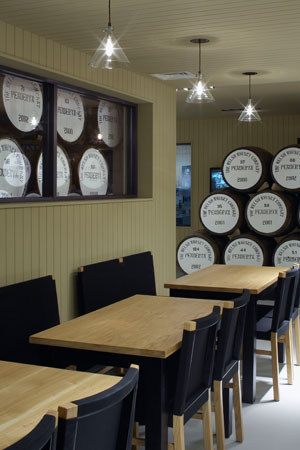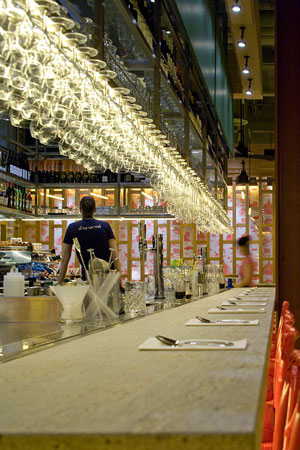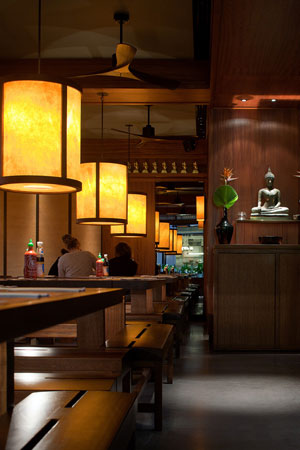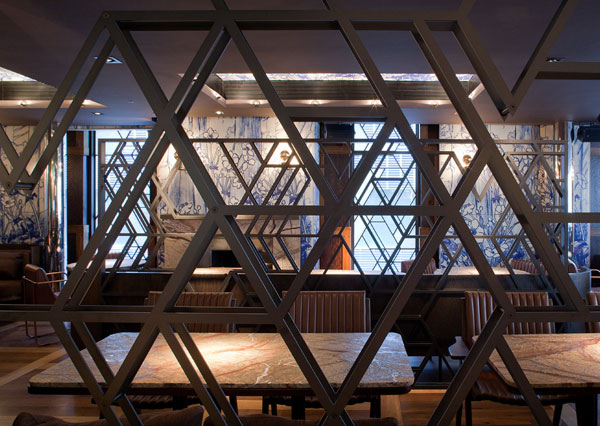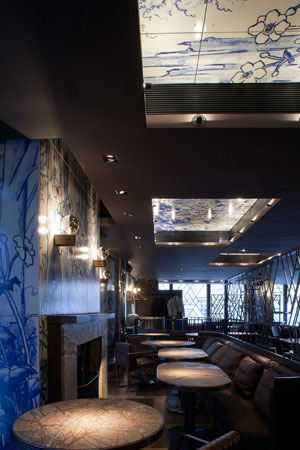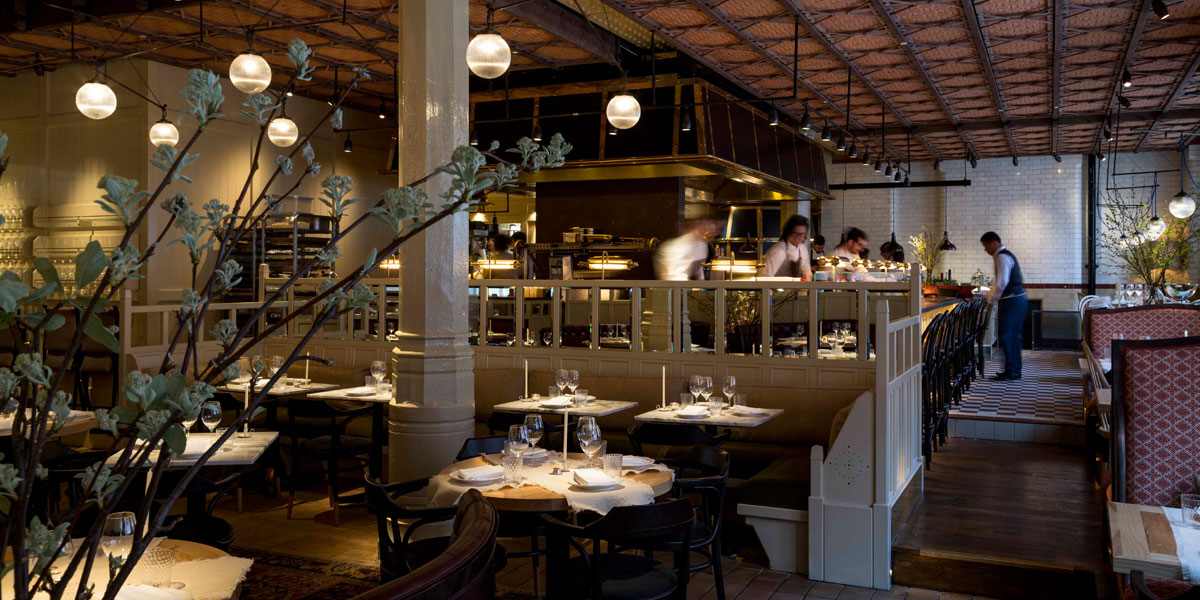
The art of restaurant design
Having designed more than 40 restaurants, the latest one, Duck and Rice, is definitely our first Cantonese gastro pub. It has been created for restaurateur Alan Yau, creator of Wagamama and Hakkasan our long-standing client since 1998.
Located in the eminently popular former Endurance Pub on Berwick Street in London’s Soho, Duck and Rice is Alan’s first return to Chinese cooking since Yauatcha, which is coincidentally next-door. Combining craft beers with authentic cuisine provides an architectural opportunity with the display of copper brewing equipment in the space, next to the bar. This typifies our design sincerity – making processes visible – something we achieve in our restaurants where food or drink preparation is integrated with the dining experience. In our Penderyn project we placed whisky casks providing graphic dividers in the tasting hall, in the Chiltern Firehouse the bonnet kitchen range is centre stage in the space and in the future Martini Lounge of the Great Northern Hotel a traditional drinks trolley will be redolent of 1950’s Madison Avenue cool cocktail life.
A pub setting is incomplete without fire, and at Duck and Rice we have set out rhythmically wood burning stoves with intimate seating groups gathered around. We’ve taken the 1960s pub right back to its concrete frame, rebuilt it and re-clad it in beautiful brickwork, and put in an extraordinary new window system which perches above Berwick Street Market opening up the street scene into the interior.
Blue and white ceramic tiles with floral chinoiserie line columns and walls following in the long tradition of fire glazing - dating back to the Tang Dynasty - is a subtle intertwinement of Chinese iconography with a modern take of a traditional English pub. Intense vivid blue in a triangulated geometric pattern adorns the staircase, linking vertically the three floors of the project. Designed in collaboration with Alan Yau’s team - Autoban, the loose furniture has been exquisitely made by De La Espada. Also for Alan Yau and his design team, we recently completed Babaji, a Turkish pizza restaurant arranged over two floors, with a follow up in Euston Station arriving soon.
With the rise of international cuisine, the London restaurant scene has transformed in the last 20 years or so since Alan founded Wagamama, which at the time was revolutionary in its minimalist and sparse canteen setting. Launching a pub, in an era defined by the tragic decline of drinking establishments, has consciously informed the design by celebrating all the varying pageantry of having a lunchtime pint, from glass display, to beer taps and a take on traditional oak stable ‘inn’ doors. Managing to defy trends, we expect this pub to capture a new community of publicans, harking all the way back to traditional inns along the Pilgrims Way, providing refuge to weary travellers.
Whereas most restaurant chains are driven by franchising and repetitious roll-out, our restaurants are created as bespoke designs for individual clients. For Naamyaa, an all-day Thai dining café in Islington, we used Ayatthaya Thai brick, historic ceramic patterns and a floor-to-ceiling display of golden deities to create an atmosphere rooted in Bangkok culture. Even with the exception –of the Busaba Eathai restaurants –our unique design concepts are created to suit each particular venue’s setting, leading to the success of this multiple restaurant in a fierce commercial market. Our latest Busaba EatThai coincides with the 15th Birthday of the architectural concept with the launch of Busaba EatThai Shoreditch. Within the new Avant Garde development in East London– we have created a new identity for the brand, following closely the design tenants from the first concept. With a new generation of foodies, and the mainstay of devoted followers, our design retains the core details, both in the food and the design, with a fresh twist.
While the huge growth in Asian cuisine has been one of the big changes in the dining scene over the last few decades, we have also created a number of restaurants with a European flavour, each a design response to the historic buildings they are embedded in. Having embryonically begun with restaurant design for Laurence Isaacsons’ Bertorelli’s which was forever captured in the movie Sliding Doors with Gwyneth Paltrow , followed by the Felix Bar, internationally recognized with its the panoramic Peninsula position in Hong Kong, described ‘ as straight out James Bond scene’ which is still trading after twenty years – we continue to create environments that provoke behaviour. In the careful design we are able to create backdrops that set a Romantic mood, or a vibrant party scene or a serious business setting. We do this by careful scale, perspective views, screening, lighting, proximity to other people, height of seating, tables, bar counter tops and the most important part which is not visible – the narrative of the space.
With the rise of international cuisine, the London restaurant scene has transformed in the last 20 years or so since Alan founded Wagamama, which at the time was revolutionary in its minimalist and sparse canteen setting. Launching a pub, in an era defined by the tragic decline of drinking establishments, has consciously informed the design by celebrating all the varying pageantry of having a lunchtime pint, from glass display, to beer taps and a take on traditional oak stable ‘inn’ doors. Managing to defy trends, we expect this pub to capture a new community of publicans, harking all the way back to traditional inns along the Pilgrims Way, providing refuge to weary travellers.
Whereas most restaurant chains are driven by franchising and repetitious roll-out, our restaurants are created as bespoke designs for individual clients. For Naamyaa, an all-day Thai dining café in Islington, we used Ayatthaya Thai brick, historic ceramic patterns and a floor-to-ceiling display of golden deities to create an atmosphere rooted in Bangkok culture. Even with the exception –of the Busaba Eathai restaurants –our unique design concepts are created to suit each particular venue’s setting, leading to the success of this multiple restaurant in a fierce commercial market. Our latest Busaba EatThai coincides with the 15th Birthday of the architectural concept with the launch of Busaba EatThai Shoreditch. Within the new Avant Garde development in East London– we have created a new identity for the brand, following closely the design tenants from the first concept. With a new generation of foodies, and the mainstay of devoted followers, our design retains the core details, both in the food and the design, with a fresh twist.
While the huge growth in Asian cuisine has been one of the big changes in the dining scene over the last few decades, we have also created a number of restaurants with a European flavour, each a design response to the historic buildings they are embedded in. Having embryonically begun with restaurant design for Laurence Isaacsons’ Bertorelli’s which was forever captured in the movie Sliding Doors with Gwyneth Paltrow , followed by the Felix Bar, internationally recognized with its the panoramic Peninsula position in Hong Kong, described ‘ as straight out James Bond scene’ which is still trading after twenty years – we continue to create environments that provoke behaviour. In the careful design we are able to create backdrops that set a Romantic mood, or a vibrant party scene or a serious business setting. We do this by careful scale, perspective views, screening, lighting, proximity to other people, height of seating, tables, bar counter tops and the most important part which is not visible – the narrative of the space.
Creating restaurants in cultural sites provides a filmic, magical backdrop. For Plum & Spilt Milk at the Great Northern Hotel, owner Jeremy Robson wanted an old-fashioned dining room with the busy atmosphere of Belle Epoque railway bars, instilling a modern exuberance.
Unlike the multiple layering of ideas which drives our work for Alan Yau, at André Balazs’ Chiltern Firehouse in Marylebone, the restaurant space is defined as a single expression –with a single energy and heart to the concept from which everything else flows. In this instance, it is the kitchen planned as a proscenium, the cooking being the main theatrical activity in the scene created within the former appliance shed of the C19th Gothic fire station, from which the seating is either is direct vista or screened for intimacy. The stepped section of the space, is what creates visibility through the room to the windows. It is conceived as a room to be seen in and observed in, whilst enjoying the participation of gathering in a ‘hall.’ Restaurants historically used to be for subversives, extroverts, intellectual circles and rebellious creative to meet and exchange conversation. Chiltern Firehouse is at the centre of the shift away from an imposed branded typography of infamous hotel restaurants enhanced with the informality of the adjacency with the kitchen
Regionally, our opulent Print Room restaurant and Ink Bar in the Grade II listed former Bournemouth Echo building make the most of the dramatic 1930s industrial architecture while recalling the formal dining environs of the Chartier restaurant in Paris. Internationally, our Verandah restaurant in Vienna at the Sans Souci Hotel has outstepped the Blaue Bar in the infamous Hotel Zacher as the place to be seen in the museum quarter. Soon to launch will be our Beach Samui where the restaurant is part of the community where produce is supplied from the village kitchen garden, within a resort building we have designed in the National Marine Park.
Our views upon restaurant design were recently incorporated into the Fine designing article by Jonathan Foyle, former CEO of the Worlds Monument Fund, on gastronomic architecture published in the Financial Times. We met him at a talk on Food and Architecture and enjoyed a lively debate with Marc Meltonville the food historian from Hampton Court and Richard Burr, the finalist builder – baker for Great British Bake Off . Jonathan Foyle in his FT article continued some of the themes engaging further with discussions with Jeremy King and Chris Corbin, owners and creators of many distinguished London restaurants designed by the late David Collins, such as the Wolsey, there is a resonance with our approach to design – “A lot of the success of any restaurant is due to the feel of the place. We never attempt to impose an idea on a building.” As architects on tackling the planning of the rooms and building, the first thing to work out is how you cook and how to present this – for example, whether the kitchen should be off-stage and out of sight, or instead positioned at the very heart of the restaurant for customers to see. “People often enjoy the feeling of being in a kitchen, rather than being served in a formal dining room.”
Colour, lighting, texture and any pictorial depiction is important, particularly in international cuisine in creating that all-important intimacy of atmosphere, where the slightest cultural connotation is examined. For example, in our restaurant to complete in 2016 in Lalit London in the former Assembly hall, we have draped canvas of Moghul scenes, where as in Dubai Busaba EatThai depiction is always in floral form, and in our latest Turkish Pizza restaurant for Alan Yau – Babaji - blue geometric tiles are used - as if they had been found in the Blue Mosque in Istanbul.
However important, design is nonetheless just one aspect of a successful restaurant. As we say in the FT article, “I think what you remember is the company, then the food”.
